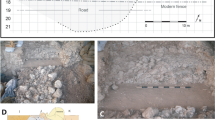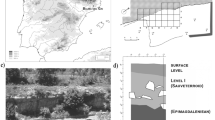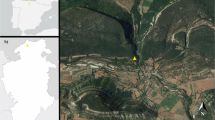Abstract
The Final Natufian level Ib from Eynan/Ain Mallaha provided a large and diversified assemblage of ungulates used here to study the seasonality of game procurement. The objective of this study was to evaluate the advantage of combining two methods, dental eruption and wear, and tooth microwear. Tooth microwear results allowed us to confirm the seasonality of procurement of red and roe deer and to narrow down its duration for the gazelle and the fallow deer. Game procurement occurred throughout the year for the roe deer. Red deer were hunted in spring and summer, and gazelle in late autumn–early winter. This approach allowed us to improve the accuracy of seasonality estimates and to increase sample size by using the entire population (young and adult individuals) for each species. The few individuals that were analysed with the two methods also permitted us to characterize the diet of the population at the time of death.




Similar content being viewed by others
Data availability
All the raw data are available in Online Resource 1.
References
Ackermans NL, Schulz-Kornas E, Clauss M, Müller DWH, Winkler DE, Kircher PR, Hummel J, Hatt JM, Kaiser TM (2018) Controlled feeding experiments with diets of different abrasiveness reveal slow development of mesowear signal in goats (Capra aegagrus hircus). J Exp Biol 221:jeb186411
Ackermans NL, Martin LF, Codron D, Hummel J, Kircher PR, Richter H, Kaiser TM, Clauss M, Hatt J (2020) Mesowear represents a lifetime signal in sheep (Ovis aries) within a long-term feeding experiment. Palaeogeogr Palaeoclimatol Palaeoecol 553:109793
Askhenazi S (2013) Reconstruction of the habitats in the ecosystem of the Final Natufian site of Ain Mallaha (Eynan). In: Bar-Yosef O, Valla F (eds) Natufian foragers in the Levant: terminal Pleistocene social changes in Western Asia. Archaeological series, International Monographs in Prehistory, Ann Arbor, pp 312-318
Azorit Casas C (2011) Guía para la determinación de la edad del ciervo ibérico (Cervus elaphus hispanicus) a través de su dentición: revisión metodológica y técnicas de elección. Anales de la Real Academia de Ciencias Veterinarias de Andalucía Oriental 24:235–264
Azorit C, Tellado S, Oya A, Moro J (2012) Seasonal and specific diet variations in sympatric red and fallow deer of southern Spain: a preliminary approach to feeding behaviour. Anim Prod Sci 52:720
Baharav D (1983a) Observation on the ecology of the mountain gazelle in the Upper Galilee, Israel. Mammalia 47:59–70
Baharav D (1983b) Reproductive strategies in female mountain and dorcas gazelles (Gazella gazella gazella and Gazella dorcas). J Zool 200:445–453
Bar-David S (2002) The reintroduced population of the Persian fallow deer – modeling population growth in time and space. PhD dissertation, Tel-Aviv University, Tel-Aviv
Bar-David S, Saltz D, Dayan T, Perelberg A, Dolev A (2005) Demographic models and reality in reintroductions: Persian fallow deer in Israel. Conserv Biol 19:131–138
Bar-Matthews M, Ayalon A, Kaufman A (1997) Late Quaternary paleoclimate in the Eastern Mediterranean region from stable isotope analysis of speleothems at Soreq Cave, Israel. Quat Res 47:155–168
Bar-Matthews M, Ayalon A, Kaufman A, Wasserburg GJ (1999) The Eastern Mediterranean paleoclimate as a reflection of regional events: Soreq cave, Israel. Earth Planet Sci Lett 166:85–95
Ben Dor Y, Armon M, Ahlborn M, Morin E, Erel Y, Brauer A, Schwab MJ, Tjallingii R, Enzel Y (2018) Changing flood frequencies under opposing late Pleistocene eastern Mediterranean climates. Sci Rep 8:8445
Ben Dor Y, Neugebauer I, Enzel Y, Schwab MJ, Tjallingii R, Erel Y, Brauer A (2019) Varves of the Dead Sea sedimentary record. Quat Sci Rev 215:173–184
Biton R, Boistel R, Rabinovich R, Gafny S, Brumfeld V, Bailon S (2016) Osteological observations on the Alytid Anura Latonia nigriventer with comments on functional morphology, biogeography and evolution history. J Morphol 277:1131–1145
Borvon A, Bridault A, Biton R, Rabinovich R, Prévost M, Khalaily H, Valla FR (2018) Finding of trout (Salmo cf. trutta) in the Northern Jordan Valley (Israel) at the end of the Pleistocene: preliminary results. J Archaeol Sci Rep 18:59–64
Bowen F, Carden RF, Daujat J, Grouard S, Miller H, Perdikaris S, Sykes N (2016) Dama dentition: a new tooth eruption and wear method for assessing the age of fallow deer (Dama dama). Int J Osteoarchaeol 26:1089–1098
Bridault A (2019) Entre zone marécageuse et collines steppiques: l’exploitation des ressources animales par les chasseurs-cueilleurs-pêcheurs d’Ain Mallaha (Eynan) (Haute Vallée du Jourdain) à la fin du Pléistocène. In: Zones humides et Archéologie. Actes du VIe Colloque international du Groupe d’Histoire des Zones Humides. Revue scientifique Bourgogne-Franche-Comté Nature, Hors-série 16, pp. 218–229
Bridault A, Rabinovich R, Simmons T (2008) Human activities, site location and taphonomic process: a relevant combination for understanding the fauna of Eynan (Ain Mallaha), level Ib (Final Natufian, Israel). In: Vila E, Gourichon L, Choyke A, Buitenhuis H (eds) Proceedings of the 8th International Meeting of the ASWA (Archaeozoology of Southwestern Asia). Maison de l’Orient et de la Méditerranée (Travaux de la Maison de l’Orient, n°49), Lyon, pp 99–118
Carranza J, Hidalgo de Trucios SJ, Medina R, Valencia J, Delgado J (1991) Space use by red deer in a Mediterranean ecosystem as determined by radio-tracking. Appl Anim Behav Sci 30:363–371
Davis SJM (1983) The age profiles of gazelles predated by ancient man in Israel: possible evidence for a shift from seasonality to sedentism in the Natufian. Paléorient 9:55–62
DeSantis LRG, Scott JR, Schubert BW, Donohue SL, McCray BM, Van Stolk CA, Winburn AA, Greshko MA, O’Hara MC (2013) Direct comparisons of 2D and 3D dental microwear proxies in extant herbivorous and carnivorous mammals. PLoS One 8:e71428
Dimentman C, Bromely HJ, Por FD (1992) Lake Hula, reconstruction of the fauna and hydrobiology of a lost Lake. The Israel Academy of Sciences and Humanities, Jerusalem
Dolev A, Saltz D, Bar-David S, Yom-Tov Y (2002) Impact of repeated releases on space-use patterns of Persian fallow deer. J Wildl Manag 66:737–746
Domínguez-Rodrigo M, Sánchez-Flores AJ, Baquedano E, Carmen Arriaza M, Aramendi J, Cobo-Sánchez L, Organista E, Barba R (2019) Constraining time and ecology on the Zinj paleolandscape: microwear and mesowear analyses of the archaeofaunal remains of FLK Zinj and DS (Bed I), compared to FLK North (Bed I) and BK (Bed II) at Olduvai Gorge (Tanzania). Quat Int 526:4–14
Ducos P (1968) L’origine des animaux domestiques en Palestine. Publications de l’Institut de Préhistoire de l’Université de Bordeaux, mémoire. Imprimerie Delmas, Bordeaux
El-Zaatari S (2010) Occlusal microwear texture analysis and the diets of historical/prehistoric hunter-gatherers. Int J Osteoarchaeol 20:67–87
Fortelius M, Solounias N (2000) Functional characterization of ungulate molars using the abrasion-attrition wear gradient: a new method for reconstructing paleodiets. Am Mus Novit 3301:1–36
Gebert C, Verheyden-Tixier H (2001) Variations of diet composition of red deer (Cervus elaphus L.) in Europe. Mammal Rev 31:189–201
Grine FE (1986) Dental evidence for dietary differences in Australopithecus and Paranthropus: a quantitative analysis of permanent molar microwear. J Hum Evol 15:783–822
Habermehl KH (1961) Alterbestimmung bei haustieren, pelztieren und jagdbarem wild. Paul Parey, Berlin
Habermehl KH (1985) Alterbestimmung bei wild-und Pelztiren: Möglichkeiten und Methoden. Ein praktischer Leitfaden für Jäger, Biologen und Tierärzte. Paul Parey, Hamburg
Hartman G, Bar-Yosef O, Brittingham A, Grosman L, Munro ND (2016) Hunted gazelles evidence cooling, but not drying, during the Younger Dryas in the southern Levant. Proc Natl Acad Sci U S A 113:3997–4002
Hofmann RR (1989) Evolutionary steps of ecophysiological adaptation and diversification of ruminants: a comparative view of their digestive system. Oecologia 78:443–457
King T, Andrews P, Boz B (1999) Effect of taphonomic processes on dental microwear. Am J Phys Anthropol 108:359–373
Lev L, Stein M, Ito E, Fruchter N, Ben-Avraham Z, Almogi-Labin A (2019) Sedimentary, geochemical and hydrological history of Lake Kinneret during the past 28,000 years. Quat Sci Rev 209:114–128
Lieberman DE (1993) The rise and fall of seasonal mobility among hunters-gatherers. The case of the Southern Levant. Curr Anthropol 34:599–631
Lieberman DE (1998) Natufian “sedentism” and the importance of biological data for estimating reduced mobility. In: Rocek TR., Bar-Yosef O (eds.) Seasonality and Sedentism. Archaeological Perspectives from Old and New World Sites. Peabody Museum of Archaeology and Ethnology, Harvard University, Cambridge, pp. 75–92
Lieberman DE, Deacon TW, Meadow RH (1990) Computer image enhancement and analysis of cementum increments as applied to teeth of Gazella gazella. J Archaeol Sci 17:519–533
Loffredo LF, DeSantis LRG (2014) Cautionary lessons from assessing dental mesowear observer variability and integrating paleoecological proxies of an extreme generalist Cormohipparion emsliei. Palaeogeogr Palaeoclimatol Palaeoecol 395:42–52
Mainland IL (1998) The lamb’s last supper: the role of dental microwear analysis in reconstructing livestock diet in the past. Environ Archaeol 1:55–62
Martin L (2000) Gazelle (Gazella spp.) behavioural ecology: predicting animal behaviour for prehistoric environments in south-west Asia. J Zool 250:13–30
Mendelssohn H, Yom-Tov Y (1999) Fauna Palestina: Mammalia of Israel. Israel Academy of Science and Humanities, Jerusalem
Mendelssohn H, Yom-Tov Y, Groves CP (1995) Gazella gazella. Mamm Species 490:1–7
Mihlbachler MC, Rivals F, Solounias N, Semprebon GM (2011) Dietary change and evolution of horses in North America. Science 331:1178–1181
Mihlbachler MC, Beatty BL, Caldera-Siu A, Chan D, Lee R (2012) Error rates and observer bias in dental microwear analysis using light microscopy. Palaeontol Electron 15:12A 22p
Munro ND, Bar-Oz G, Stutz AJ (2009) Aging mountain gazelle (Gazella gazella): refining methods of tooth eruption and wear and bone fusion. J Archaeol Sci 36:752–763
Perelberg A, Saltz D, Bar-David S, Dolev A, Yom-Tov Y (2003) Seasonal and circadian changes in the home ranges of reintroduced Persian fallow deer. J Wildl Manag 67:485–492
Putman R, Flueck WT (2011) Intraspecific variation in biology and ecology of deer: magnitude and causation. Anim Prod Sci 51:277–291
R Core Team (2019) R: a language and environment for statistical computing. Version 3.6.2. Foundation for Statistical Computing, Vienna. http://www.r-project.org/index.html
Rivals F (2019) MicrowearBivaR: a code to create tooth microwear bivariate plots in R. Zenodo, Version 1. https://doi.org/10.5281/zenodo.2587575
Rivals F, Mihlbachler MC, Solounias N (2007) Effect of ontogenetic-age distribution in fossil samples on the interpretation of ungulate paleodiets using the mesowear method. J Vertebr Paleontol 27:763–767
Rivals F, Mihlbachler MC, Solounias N, Mol D, Semprebon GM, de Vos J, Kalthoff DC (2010) Palaeoecology of the mammoth steppe fauna from the late Pleistocene of the North Sea and Alaska: separating species preferences from geographic influence in paleoecological dental wear analysis. Palaeogeogr Palaeoclimatol Palaeoecol 286:42–54
Rivals F, Solounias N, Schaller GB (2011) Diet of Mongolian gazelles and Tibetan antelopes from steppe habitats using premaxillary shape, tooth mesowear and microwear analyses. Mamm Biol 76:358–364
Rivals F, Prignano L, Semprebon GM, Lozano S (2015) A tool for determining duration of mortality events in archaeological assemblages using extant ungulate microwear. Sci Rep 5:17330. https://doi.org/10.1038/srep17330
Rodriguez-Berrocal J (1978) Introducción al estudio y valoración de los recursos forestales y arbustivos para el ciervo en el área ecológica de Sierra Morena: I, Estudio de la dieta del ciervo. Arch Zootec 27:73–82
Rosen AM (2010) Natufian plant exploitation: managing risk and stability in an environment of change. Eurasian Prehist 7:113–127
Rosen AM, Rivera-Collazo I (2012) Climate change, adaptive cycles, and the persistence of foraging economies during the late Pleistocene/Holocene transition in the Levant. Proc Natl Acad Sci U S A 109:3640–3645
San José C, Ferrari N, Lovari S (1995) Distribution and population parameters of roe deer in Tuscany, Italy. In: Wotschikowsky U (ed) Proceedings of the second roe deer meeting. Wildbiologische Gesellschaft, München, pp 55–60
San José C, Braza F, Aragón S, Delibes JR (1997) Habitat use by roe and red deer in southern Spain. Misc Zool 20:27–38
Semprebon GM (2002) Advances in the reconstruction of extant ungulate ecomorphology with applications to fossil ungulates. PhD dissertation, University of Massachusetts, Amherst
Semprebon GM, Rivals F (2007) Was grass more prevalent in the pronghorn past? An assessment of the dietary adaptations of Miocene to recent Antilocapridae (Mammalia: Artiodactyla). Palaeogeogr Palaeoclimatol Palaeoecol 253:332–347
Semprebon GM, Rivals F (2010) Trends in the paleodietary habits of fossil camels from the Tertiary and Quaternary of North America. Palaeogeogr Palaeoclimatol Palaeoecol 295:131–145
Semprebon GM, Godfrey LR, Solounias N, Sutherland MR, Jungers WL (2004) Can low-magnification stereomicroscopy reveal diet? J Hum Evol 47:115–144
Simmons T (2013) Avifauna of the Final Natufian of Eynan. In: Bar-Yosef O, Valla FR (eds) Natufian foragers in the Levant. Terminal Pleistocene Social Changes in Western Asia. International Monographs in Prehistory, Ann Arbor, pp 284–292
Solounias N, Semprebon G (2002) Advances in the reconstruction of ungulate ecomorphology with application to early fossil equids. Am Mus Novit 3366:1–49
Stiner MC (1990) The use of mortality patterns in archaeological studies of hominid predatory adaptations. J Anthropol Archaeol 9:305–351
Tchernov E (1984) Commensal animals and human sedentism in the Middle East. In: Clutton-Brock J, Grigson C (eds) Animals and Archaeology. 3: Early Herders and Their Flocks. Archaeopress (BAR Int. Ser. 202), Oxford, pp 91–115
Teaford MF, Oyen OJ (1989) Differences in the rate of molar wear between monkeys raised on different diets. J Dent Res 68:1513–1518
Tomé C, Vigne JD (2003) Roe deer (Capreolus capreolus) age at death estimates: new methods and modern reference data for tooth eruption and wear, and for epiphyseal fusion. Archaeofauna 12:157–173
Torres RT, Virgós E, Santos J, Linnell JDC, Fonseca C (2012) Habitat use by sympatric red and roe deer in a Mediterranean ecosystem. Anim Biol 62:351–366
Valla FR (2018) Sedentism, the “point of no return”, and the Natufian issue. An historical perspective. Paléorient 44:19–33
Valla RF, Khalaily H, Valladas H, Kaltnecker E, Bocquentin F, Cabellos T, Bar-Yosef-Mayer DE, Le Dosseur G, Regev L, Chu V, Weiner S, Boaretto E, Samuelian N, Valentin B, Delerue S, Poupeau G, Bridault A, Rabinovich R, Simmons T, Zohar I, Ashkenazi S, Delgado Huertas A, Spiro B, Mienis HK, Rosen AM, Porat N, Belfer-Cohen A (2007) Les Fouilles de Ain Mallaha (Eynan) de 2003 à 2005: Quatrième Rapport Préliminaire. J Israel Prehist Soc 37:135–379
Valla FR, Khalaily H, Samuelian N, Bocquentin F, Bridault A, Rabinovich R (2017) Eynan (Ain Mallaha). In: Enzel Y, Bar-Yosef O (eds) Quaternary of the Levant: environment. Climate Change and Humans. Cambridge University Press, Cambridge, pp 295–302
Verheyden-Tixier H, Renaud PC, Morellet N, Jamot J, Besle JM, Dumont B (2008) Selection for nutrients by red deer hinds feeding on a mixed forest edge. Oecologia 156:715–726
Weissbrod L, Marshall FB, Valla FR, Khalaily H, Bar-Oz G, Auffray JC, Vigne JD, Cucchi T (2017) Origins of house mice in ecological niches created by settled hunter-gatherers in the Levant 15,000 y ago. Proc Natl Acad Sci U S A 114:4099–4104
Acknowledgements
We are thankful to C. Azorit for providing us with information on the birth period of red deer in the Sierra de Andújar region. We are grateful to Esther Lachman for editing the manuscript. Finally, we acknowledge the three reviewers whose comments helped to improve this manuscript.
Code availability
MicrowearBivaR: a Code to Create Tooth Microwear Bivariate Plots in R. Zenodo, Version 1. https://doi.org/10.5281/zenodo.2587575.
Funding
This work was supported by a mobility grant to FR (Salvador de Madariaga grant PRX17/00116 from the Ministerio de Educación, Cultura y Deporte). The research of FR is supported by projects 2017 SGR 836 from the Generalitat de Catalunya, projects HAR2016-76760-C3-1-P and PID2019-103987GB-C31 from the Ministerio de Ciencia e Innovación and the CERCA Program/Generalitat de Catalunya. The research at Eynan/Ain Mallaha is supported by the PRC CNRS-MOST 2018–2020 ‘Human Impact on the Northern Jordan Valley (Hula Valley) using archaeological and genetic proxies’ (A. Bridault and R. Rabinovich, coordinators).
Author information
Authors and Affiliations
Corresponding author
Ethics declarations
Conflict of interest
The authors declare that they have no conflict of interest.
Additional information
Publisher’s note
Springer Nature remains neutral with regard to jurisdictional claims in published maps and institutional affiliations.
Electronic supplementary material
ESM 1
(XLSX 36 kb)
Rights and permissions
About this article
Cite this article
Rivals, F., Rabinovich, R., Khalaily, H. et al. Seasonality of the Final Natufian occupation at Eynan/Ain Mallaha (Israel): an approach combining dental ageing, mesowear and microwear. Archaeol Anthropol Sci 12, 232 (2020). https://doi.org/10.1007/s12520-020-01190-3
Received:
Accepted:
Published:
DOI: https://doi.org/10.1007/s12520-020-01190-3




